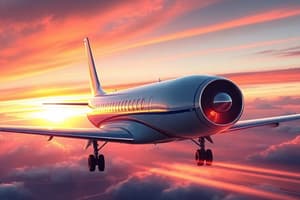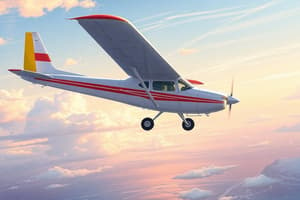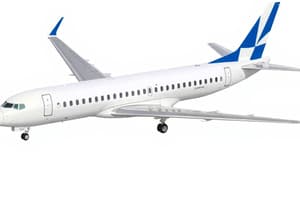Podcast
Questions and Answers
What does the term 'Appliance' refer to in the context of aviation regulations?
What does the term 'Appliance' refer to in the context of aviation regulations?
- Any instrument or equipment used in operating an aircraft in flight (correct)
- Any software used for aircraft navigation
- Only parts related to the airframe
- Any vehicle used for land transport
Which statement accurately describes ATSOA authorisations?
Which statement accurately describes ATSOA authorisations?
- They are limited to communication equipment only
- They are exclusively for certifying airframes and engines
- They can only be issued for safety equipment
- They involve certification of various articles used on civil aircraft (correct)
What is required to manufacture aircraft or their parts under CASR Part 21?
What is required to manufacture aircraft or their parts under CASR Part 21?
- Compliance with the National Standards for Manufacturing
- A general manufacturing license from the government
- A business license and safety inspection
- Manufacturing approval under CASR Part 21 (correct)
Which of the following methods is NOT a way to obtain production approval for aircraft manufacturing?
Which of the following methods is NOT a way to obtain production approval for aircraft manufacturing?
Which advisory circular relates specifically to Manufacturing Approval?
Which advisory circular relates specifically to Manufacturing Approval?
Under what circumstances can parts other than aircraft, engines, and propellers be manufactured in Australia?
Under what circumstances can parts other than aircraft, engines, and propellers be manufactured in Australia?
What is a potential outcome of failing to comply with minimum performance standards set forth by ATSOA?
What is a potential outcome of failing to comply with minimum performance standards set forth by ATSOA?
Which type of authorisation is issued for components like wheels or oxygen systems in civil aircraft?
Which type of authorisation is issued for components like wheels or oxygen systems in civil aircraft?
What is the maximum takeoff weight (MTOW) for commuter category aircraft?
What is the maximum takeoff weight (MTOW) for commuter category aircraft?
Which of the following best describes the Commuter category aircraft?
Which of the following best describes the Commuter category aircraft?
Which Part specifies the airworthiness standards for Normal category rotorcraft?
Which Part specifies the airworthiness standards for Normal category rotorcraft?
What is a characteristic of transport category aircraft?
What is a characteristic of transport category aircraft?
What is a requirement for commuter category aircraft regarding design?
What is a requirement for commuter category aircraft regarding design?
Which type of aircraft falls under CASR Part 29 regulations?
Which type of aircraft falls under CASR Part 29 regulations?
How many passenger seats does a Normal category rotorcraft have according to CASR Part 27?
How many passenger seats does a Normal category rotorcraft have according to CASR Part 27?
Which category includes multi-engine aircraft primarily for public transport?
Which category includes multi-engine aircraft primarily for public transport?
What is the purpose of a Special Flight Permit (SFP)?
What is the purpose of a Special Flight Permit (SFP)?
What must be done before issuing a Special Flight Permit?
What must be done before issuing a Special Flight Permit?
Who must be the legal owner of the aircraft according to CASR Part 47?
Who must be the legal owner of the aircraft according to CASR Part 47?
Which of the following is a requirement to be a Registration Holder?
Which of the following is a requirement to be a Registration Holder?
What type of proof must individuals provide to be a Registration Holder?
What type of proof must individuals provide to be a Registration Holder?
What is required of a Registered Operator?
What is required of a Registered Operator?
Which of the following descriptions best defines 'Registered Operator'?
Which of the following descriptions best defines 'Registered Operator'?
What happens to a Special Flight Permit once its specified period expires?
What happens to a Special Flight Permit once its specified period expires?
What is the maximum seating configuration for Normal category aircraft, excluding pilot seats?
What is the maximum seating configuration for Normal category aircraft, excluding pilot seats?
What is the Maximum Take-off Weight (MTOW) limit for Normal category aircraft?
What is the Maximum Take-off Weight (MTOW) limit for Normal category aircraft?
Which type of operation is excluded from the definition of normal, non-aerobatic operation?
Which type of operation is excluded from the definition of normal, non-aerobatic operation?
What is the stall speed limit for very light aircraft in landing configuration?
What is the stall speed limit for very light aircraft in landing configuration?
Which of the following describes the restrictions placed on very light aircraft?
Which of the following describes the restrictions placed on very light aircraft?
Which categories of aircraft are governed by the Airworthiness Standards for the issue of TCs?
Which categories of aircraft are governed by the Airworthiness Standards for the issue of TCs?
What does 'non-aerobatic operation' include?
What does 'non-aerobatic operation' include?
What design feature is a requirement for aircraft type-certificated under the CS – Very Light Aircraft (VLA) design requirements?
What design feature is a requirement for aircraft type-certificated under the CS – Very Light Aircraft (VLA) design requirements?
What is a requirement for a multi-engine aircraft to be certificated in the Transport Category if it weighs less than 5700 kg MTOW?
What is a requirement for a multi-engine aircraft to be certificated in the Transport Category if it weighs less than 5700 kg MTOW?
Which category can a commuter aircraft belong to, even if it exceeds 5700 kg MTOW?
Which category can a commuter aircraft belong to, even if it exceeds 5700 kg MTOW?
What must aircraft meet to qualify for certification under CASR Part 21 as Primary category aircraft?
What must aircraft meet to qualify for certification under CASR Part 21 as Primary category aircraft?
What is one of the primary advantages of the simplified certification procedures under CASR 21.24 for Primary category aircraft?
What is one of the primary advantages of the simplified certification procedures under CASR 21.24 for Primary category aircraft?
What type of aircraft does CASR Part 21 introduce as a new category similar to the FAA's classification?
What type of aircraft does CASR Part 21 introduce as a new category similar to the FAA's classification?
Which of the following is NOT covered under the obligations of the registration holder?
Which of the following is NOT covered under the obligations of the registration holder?
What design feature is one of the conditions for an aircraft to be classified under Transport Category based on FAR Part 23?
What design feature is one of the conditions for an aircraft to be classified under Transport Category based on FAR Part 23?
What is a common purpose of Special Flight Permits as outlined under the relevant aviation regulations?
What is a common purpose of Special Flight Permits as outlined under the relevant aviation regulations?
Which individuals are considered eligible persons under the defined criteria?
Which individuals are considered eligible persons under the defined criteria?
What identification is required for an individual to prove eligibility as a Registered Operator?
What identification is required for an individual to prove eligibility as a Registered Operator?
An organisation must provide which document to prove its eligibility?
An organisation must provide which document to prove its eligibility?
Which of the following is exempt from the regulations outlined in Part 47?
Which of the following is exempt from the regulations outlined in Part 47?
Which type of aircraft is NOT included under Part 47 regulations?
Which type of aircraft is NOT included under Part 47 regulations?
What entity is responsible for maintaining the register of all registered aircraft in Australia?
What entity is responsible for maintaining the register of all registered aircraft in Australia?
In order to prove lawfulness for a foreign corporation, what must it show?
In order to prove lawfulness for a foreign corporation, what must it show?
Which of the following documents would NOT suffice as proof of citizenship?
Which of the following documents would NOT suffice as proof of citizenship?
Flashcards
Normal Category Aircraft
Normal Category Aircraft
Aeroplanes designed for non-aerobatic flight, with 9 or fewer seats and a maximum takeoff weight of 5700 kg or less.
Airworthiness Standards (Normal Category)
Airworthiness Standards (Normal Category)
Aircraft must meet standards of CASR Part 23 (aeroplanes) or Part 27 (rotorcraft) to be certified, or be accepted from recognized countries, or comply with previous standards.
Very Light Aircraft (VLA)
Very Light Aircraft (VLA)
A specific type of normal category aircraft with more stringent design requirements. Often single engine, two or less seats, low takeoff weight (MTOW <750kg), and stall speed less than 45 knots in landing configuration.
Non-Aerobatic Operation
Non-Aerobatic Operation
Signup and view all the flashcards
Maximum Take-off Weight (MTOW)
Maximum Take-off Weight (MTOW)
Signup and view all the flashcards
CASR Part 23
CASR Part 23
Signup and view all the flashcards
Special Federal Aviation Regulations (SFAR)
Special Federal Aviation Regulations (SFAR)
Signup and view all the flashcards
Operational Restrictions
Operational Restrictions
Signup and view all the flashcards
Commuter Category Aircraft
Commuter Category Aircraft
Signup and view all the flashcards
Normal Category Rotorcraft
Normal Category Rotorcraft
Signup and view all the flashcards
Transport Category Aircraft
Transport Category Aircraft
Signup and view all the flashcards
Primary Category Aircraft
Primary Category Aircraft
Signup and view all the flashcards
What is the purpose of Special Flight Permits?
What is the purpose of Special Flight Permits?
Signup and view all the flashcards
Certificates of Registration
Certificates of Registration
Signup and view all the flashcards
What is the purpose of Noise Certificates?
What is the purpose of Noise Certificates?
Signup and view all the flashcards
Weight Schedules
Weight Schedules
Signup and view all the flashcards
Why are Radio Station Licences and Approvals important?
Why are Radio Station Licences and Approvals important?
Signup and view all the flashcards
What is a Special Flight Permit?
What is a Special Flight Permit?
Signup and view all the flashcards
When is a Special Flight Permit Issued?
When is a Special Flight Permit Issued?
Signup and view all the flashcards
What is a Registration Holder?
What is a Registration Holder?
Signup and view all the flashcards
What is a Registered Operator?
What is a Registered Operator?
Signup and view all the flashcards
Who can be a Registration Holder?
Who can be a Registration Holder?
Signup and view all the flashcards
What proof is needed for a Registration Holder?
What proof is needed for a Registration Holder?
Signup and view all the flashcards
Who can be a Registered Operator?
Who can be a Registered Operator?
Signup and view all the flashcards
What is the main purpose of CASR Part 47?
What is the main purpose of CASR Part 47?
Signup and view all the flashcards
Eligible Person for Aviation Registration
Eligible Person for Aviation Registration
Signup and view all the flashcards
Australian Civil Aircraft Register
Australian Civil Aircraft Register
Signup and view all the flashcards
Aircraft Exempt from Registration
Aircraft Exempt from Registration
Signup and view all the flashcards
Registration Requirements for Individuals
Registration Requirements for Individuals
Signup and view all the flashcards
Registration Requirements for Organizations
Registration Requirements for Organizations
Signup and view all the flashcards
Certified True Copy
Certified True Copy
Signup and view all the flashcards
Unmanned Aerial Vehicle (UAV)
Unmanned Aerial Vehicle (UAV)
Signup and view all the flashcards
Appliance (Aviation)
Appliance (Aviation)
Signup and view all the flashcards
Article (Aviation)
Article (Aviation)
Signup and view all the flashcards
ATSOA
ATSOA
Signup and view all the flashcards
Production Certificate (PC)
Production Certificate (PC)
Signup and view all the flashcards
APMA
APMA
Signup and view all the flashcards
Manufacturing Approval (Under CASR Part 21)
Manufacturing Approval (Under CASR Part 21)
Signup and view all the flashcards
Two Production Methods (CASR Part 21)
Two Production Methods (CASR Part 21)
Signup and view all the flashcards
General Rule for Manufacturing Parts
General Rule for Manufacturing Parts
Signup and view all the flashcards
Study Notes
Part 23 Airworthiness Standards
- This code outlines airworthiness standards for issuing and amending certificates for various airplane categories.
- Categories include Normal, Utility, Aerobatic, and Commuter.
Normal Category Aircraft
- Designed for non-aerobatic operations.
- Seating configuration of nine seats or fewer.
- Maximum Take-off Weight (MTOW) of 5700 kg or less.
- Must meet airworthiness standards of CASR Part 23.
- Very Light Aircraft (VLA) restrictions include single engine, two seats or less, MTOW of 750 kg or less, and stall speed of 45 knots in landing configuration.
- Additional restrictions apply to JAR-VLA types with engines certified under Part 32.
- Nine-seat maximum may include extensions under SFAR 41 and SFAR 23.
Utility Category Aircraft
- Allows limited aerobatic operations.
- Seating configuration of nine seats or less, MTOW of 5700 kg or less.
- Meant for more operational flexibility as basic training aircraft compared to Normal category "plus" aircraft.
- Additional design requirements include increased structural load and higher dive speed.
- Limited aerobatic operation includes spins (if approved), lazy eights, chandelles, and steep turns with bank angles not exceeding 90°.
Aerobatic Category Aircraft
- Designed for aerobatic operations.
- Seating configuration of nine seats or less, MTOW of 5700 kg or less.
- No flight restrictions other than those required for certification.
Commuter Category Aircraft
- Designed for non-aerobatic operations.
- Multi-engine and propeller driven.
- Seating configuration of 19 seats or less, and MTOW of 8618 kg or less.
- Higher safety standards in design and performance compared to Normal category aircraft.
Part 27 Rotorcraft
- Specifies airworthiness standards for Normal category helicopters.
- MTOW up to 3175 kg, up to nine passenger seats.
- Standards based on US Federal Aviation Regulations Part 27.
Parts 25 and 29 Transport Category
- Multi-engine aircraft, primarily for regular public transport.
- MTOW usually over 5700 kg (aeroplanes).
- Meets CASR Part 25 or 29 requirements or automatically accepted from recognised countries.
- Transport category may include aircraft under 5700 kg MTOW but only if that is the manufacture's choice.
- Additional specifications for multi-engine configuration may be required.
Certification of Aircraft, Parts, and Appliances II (10.5)
- Discusses the structure and intent of CASR Part 21 (1998) with focus on special flight permits, registration, noise certificates, and regular aircraft weighing.
- Discusses the structure and intent of regulations and approvals for issuing radio station licenses and approvals.
Part 21 Primary Category
- Identical to FAA Primary category.
- Primarily for pleasure, personal use.
- Aircraft design and certification procedures are simplified.
- Optional category.
Special Flight Permits
- Temporary CofA invalidity due to damage, lack of maintenance, or inability for CofA issue.
- Operation in compliance with specified conditions/restrictions.
- Not authorization to deviate from regulations.
- Covers repair/maintenance, delivery/export, evacuating, search/rescue, emergency situations.
- A CASA or authorised person issues SFPs.
Certificate of Registration (Part 47)
- Defines Registration Holder (legal owner) and Registered Operator (airworthiness, maintenance control).
- Registration holders must be legal entities (individual, corporation, government agency).
Registered Operator
- Eligible persons (residents of Australia, corporations, etc.).
- Identification based on residency, age, citizenship, permanent visa, etc.
CASR Part 47
- Covers aircraft registration procedures and requirements for assignment of registration marks.
- Identifies aircraft types exempt from Part 47, and data required to be kept on the Australian Civil Aircraft Register.
Noise Certification
- Australian noise certification requirements outlined in AC 21.13 required prior to Australian operation.
- Regulations based on Air Navigation (Aircraft Noise) Regulations, 1984.
Weight Schedules
- Data for transport and commuter aircraft (weight and balance reports) based on actual weighing within 12 months of application for export airworthiness approval..
- Includes equipment list and moments of required and optional items.
- Procedures for weighting and keeping weight data records documented.
Radio Station Licences
- Addresses the licensing of aircraft radio communication and navigation equipment.
- Introduces the Australian Communications Media Authority (ACMA) class licence system (18 August 2016).
- Covers spectrum management, conditions, and issuance for common frequencies and equipment.
- Includes installation procedures and approval processes for radio systems, including approvals, documentation and testing requirements.
Approval of Airborne Radio Systems
- CAO 100.37 specifies the procedures for approval of installation/changes for airborne radio systems.
Licensing of Ground Operations Personnel
- CASR Part 64 consolidates ground operation personnel licensing rules.
- Includes Aeronautical Radio Operator Certificate (AROC) requirements.
Eligibility for Aeronautical Radio Operator Certificate
- Specifies criteria for applicants to conduct ground-based or flight (in-flight) operations.
- Covers individuals, pilot instructors, and training organisations.
Grant of Aeronautical Radio Operator Certificate
- Details of who can operate radios, and those needing the qualification (e.g., ground handlers, aircraft maintenance engineers).
- Applicants are required to meet requirements prior to receiving the certificate.
Parts 21 and 42 of CASR 1998 (10.6)
- Detailed descriptions of CASR Part 21 and 42 structures, provisions and intents relating to continuing airworthiness.
Part 21 of CASR 1998
- Ensures continuing airworthiness of Australian aircraft.
- Covers type certification, airworthiness certification, production certification, and identification of aircraft and aeronautical products.
CASR Part 21 Definitions
- Defines terms like "appliance" and "article".
- Explains Australian Technical Standard Order Authorisation (ATSOA) that is involved in approving materials, parts, and other components used on civil aircraft.
Production Certification and Approval
- Methods for obtaining approval for aircraft, aircraft engines, and propeller production under specified CASR Part 21 Subparts, including references to advisory circulars, certificates, and approvals
Australian Parts Manufacturing Approval
- Procedures for approving parts for aircraft, aircraft engines, and propellers.
Australian Technical Standard Order Authorisation
- Details of the ATSOA system of approval for manufacture and installation of aeronautical products.
Identification of Aircraft and Aeronautical Products
- Details the requirements for identification plates for aircraft, engines, and propellers, including location, information to be included, and data plate design requirements.
Studying That Suits You
Use AI to generate personalized quizzes and flashcards to suit your learning preferences.




